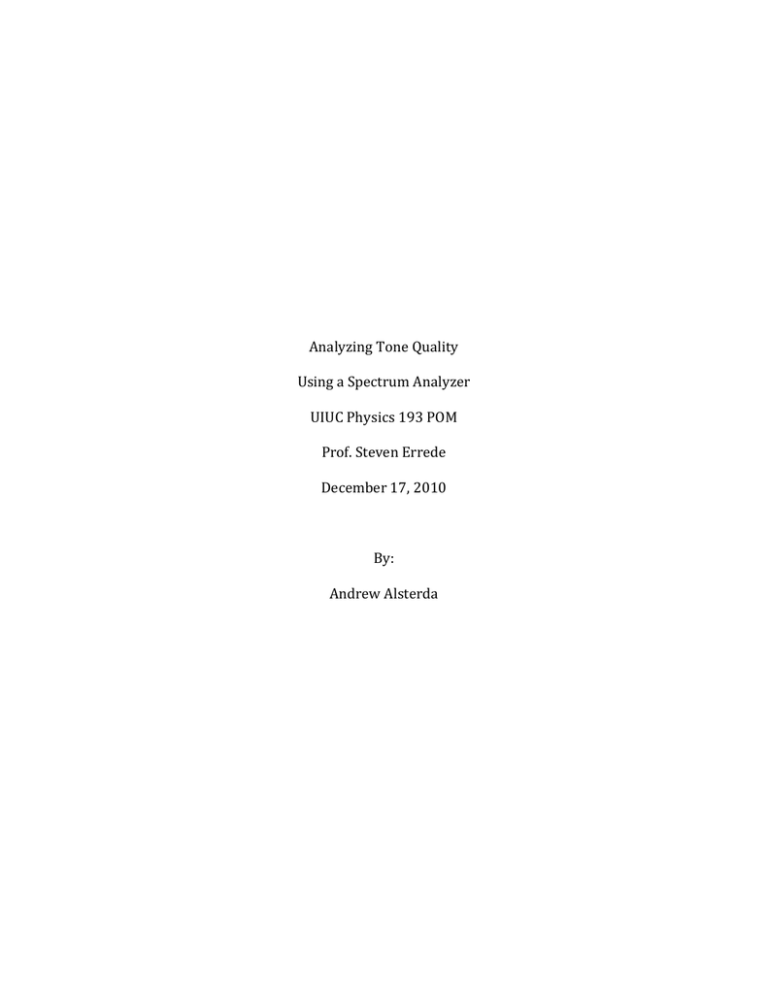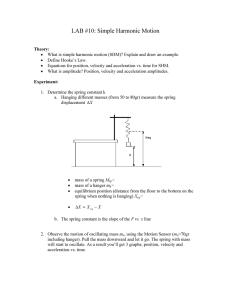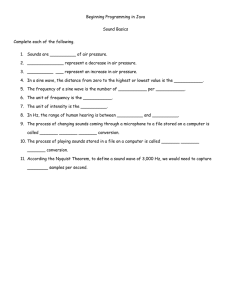Analyzing Tone Quality Using a Spectrum Analyzer UIUC Physics
advertisement

Analyzing Tone Quality Using a Spectrum Analyzer UIUC Physics 193 POM Prof. Steven Errede December 17, 2010 By: Andrew Alsterda Introduction The purpose of this experiment is to investigate how the different properties of a tone determine the quality (aesthetic appeal) of its sound. After analyzing two different tones using a spectrum analyzer, the results will be compared to explain why a tone sounds the way it does. The characteristics of a sound that determine its tone are loudness, pitch, and quality. Loudness is a measure of the intensity of a sound, which is determined by the power of its source, and the distance the source is from the ear. Pitch is mostly determined by the frequency of a tone, which allows two tones to be compared in terms of low or high. The quality of a tone is what distinguishes it from other tones with the same loudness and pitch. While the intensity of a sound does affect its aesthetic appeal, the focus of this experiment will be on quality. Therefore, the intensity of the two samples will be kept relatively constant, which will make the results more transparent. The pitch of the samples will also be kept constant for the same reason. The samples will be recorded at middle C on the piano, which has a frequency of 256 Hz. This will allow both the low and high frequencies of the tones to be equally represented. In order to analyze quality most effectively, the quality of the two samples should vary as much as possible. So when choosing tones to sample, it would make the most sense to compare an aesthetically appealing tone to a tone that is not appealing. The simplest tone is a sine wave, also known as a pure tone, and has a single frequency. Sine waves are uninteresting to the ear because they lack ‐2‐ complexity. This is why pure tones are rare in music. On the other hand, instruments typically produce complex tones. Complex tones are a combination of simple tones with varying frequency and amplitude. The number, frequency, and amplitude of the simple (partial) tones determine the overall quality of a complex tone. Each partial tone is also known as a harmonic. The most significant harmonic has the greatest amplitude and is known as the fundamental. The frequency of each consequent harmonic must be related to the fundamental frequency by integer multiples (1,2,3,4,5…etc.). So, because a sine wave is the least appealing tone, a tone aesthetically similar to sine wave will be used. Because leads typically have the most interesting and appealing tone, a synth lead will be used as the aesthetically appealing tone. The two samples will first be compared by ear so that a hypothesis can be made. Then, the two samples will be compared through a spectrum analysis software. A spectrum analyzer is a device or software that can be used to examine the spectral composition of an acoustic waveform. The spectrum analyzer measures several different properties of waves including frequency, amplitude, and phase. The phase of a wave denotes its position in the cycle of its waveform. When waves are heard together, their amplitudes are summed to produce a new wave. This means that when two identical waves are completely out of phase, the waves will cancel each other out. This is important when analyzing tone, because a waveform with more complex phase relationships will have an overall more complex sound. ‐3‐ Hypothesis If the spectral composition of a tone aesthetically similar to a sine wave is compared to that of an aesthetically appealing tone, then the aesthetically appealing tone should have a more complex harmonic structure. Both tones should have their fundamental harmonic at 256 Hz (middle C), followed by a second harmonic at 512 Hz, a third harmonic at 768 Hz, a fourth harmonic at 1024 Hz, and so on. While a real sine wave would only have the single harmonic at 256 Hz, the sample that was used could be heard to clearly contain other higher order harmonics. Also, while the harmonics of both samples should have the same frequencies, the amplitudes of the synth lead harmonics should fluctuate over time. This is because the synth lead oscillates. The phase of the synth lead harmonics should also fluctuate over time for the same reason. On the other hand, the harmonics of the sine wave should have constant amplitudes over time, and as well, the phase of the sine wave harmonics should be constant over time. This is because the sine wave does not oscillate. Procedure Obtaining Sound Files: 1. Open Reason. 2. Find an instrument that is aesthetically similar to a sine wave. 3. Play a note (preferably middle C) and record a 15 second sample. 4. Go to File… Export Song as Audio File… and save the .wav file with a sample rate of 44,100 Hz and a 24 bit depth. ‐4‐ 5. Repeat steps 3 and 4 with an aesthetically appealing instrument (this will constitute as the complex tone). Analyzing Samples 1. Open MATLAB, open the “wav_analysis” folder, and then run the “wav_analysis.m” program. 2. In the wav_analysis window, go to File… Open WAV… and open the sine wave sample. 3. Choose the channel you wish to analyze when prompted “Which Channel?” 4. Click “Clip Waveform” and clip the fifteen second sound file into the four second interval that has the most consistent amplitude. 5. Click “Choose Harmonics” and select the frequency intervals of the first six harmonics. 6. Click “Analyze” and wait for the program to finish fitting the harmonics. 7. Click “Show Harmonic Fits” and “Show Aggregate Plots” to view the results. 8. Go to File… Save All. 9. Close MATLAB and then repeat steps 1 through 8 for the aesthetically appealing sample. ‐5‐ Results Sine Wave Graphs Synth Lead Graphs Figure 1 Figure 5 Figure 2 Figure 6 Figure 3 Figure 7 ‐6‐ Figure 4 Figure 8 Analysis The spectrogram of the sine wave (Fig. 1) does support the hypothesis. In fig. 2, a graph of frequency vs. amplitude, the fundamental harmonic can be seen clearly at 256 Hz, followed by a second harmonic at 512 Hz, a third harmonic at 768 Hz, a fourth harmonic at 1024 Hz, and so on. Also, the amplitudes of sine wave’s higher order harmonics are all smaller than the fundamental’s amplitude by at least a power of ten (Fig. 2). In fig. 3, a graph of harmonic amplitudes vs. time, the amplitudes of the sine wave harmonics are constant over time. In fig. 4, a graph of harmonic phases vs. time, the relative phase of the higher order harmonics compared to the fundamental are also constant overtime. The spectrogram of the synth lead (Fig. 5) does not completely agree with the hypothesis. In fig. 6, a graph of frequency vs. amplitude, the fundamental harmonic is not at 256 Hz but rather at about 64 Hz. The second harmonic is at about 128 Hz (not 512 Hz); the third harmonic is at about 256 Hz (not 768 Hz); the fourth harmonic is at about 384 Hz (not 512 Hz); and the fifth harmonic is at about 512 Hz. ‐7‐ Also, the amplitudes of the synth lead’s higher harmonics are not all significantly smaller than the fundamental amplitude (Fig. 6). The amplitude of the second, third, and fourth harmonics are all within a power of ten of the fundamental. However, fig 7, a graph of harmonic amplitudes vs. time, does support the hypothesis. The amplitudes of the synth lead harmonics are clearly fluctuating over time. In fig. 8, a graph of harmonic phases vs. time, the relative phase of the higher order harmonics are also changing overtime. Conclusion: The results of this experiment did somewhat support the overall hypothesis, however there were a few discrepancies. The harmonic structure of the synth lead is obviously more complex than that of the sine wave, but the harmonics of the synth lead did not agree with the hypothesis. Since the synth lead sample was recorded at middle C, the fundamental of the tone should have been at about 256 Hz. The spectrum analysis software mostly likely had trouble analyzing the sample because it oscillates too much. Further investigation is necessary to understand exactly why the harmonics of the synth lead were off. Besides the synth lead harmonics, the rest of the data fits the hypothesis. The sine wave sample is indeed not a sine wave because it has multiple harmonics. A pure sine wave would only have a single fundamental frequency. The higher order harmonics of the sine wave (512 Hz, 768 Hz, 1024 Hz, etc.) were integer multiples of the fundamental middle C (256 Hz) as the hypothesis predicted. ‐8‐ The amplitudes of the sine wave harmonics were constant which differed from the synth lead, which had fluctuating harmonic amplitudes. This helps explain why the synth lead is more interesting to hear. The fluctuating harmonics are complex which is aesthetically appealing while constant amplitudes are boring. The relative phase of the sine wave harmonics were also constant which differed from the synth lead. The relative phase of the synth lead harmonics changed a great deal over time. This also adds to the complexity of the of the synth lead tone, further explaining why it is more interesting to hear. A major factor that was over looked when making the hypothesis was the amplitudes of the higher order harmonics compared to the fundamental frequency. While the amplitudes of the sine wave’s higher order harmonics were all significantly smaller than the fundamental (by at least a power of ten), the synth lead’s were not. The synth lead has three higher order harmonics that are comparable to the fundamental’s amplitude, and therefore, will all be almost equally heard. So while the harmonics of the sine wave will be background, the harmonics of the synth lead will be core components of the wave. It seems that being able to hear multiple harmonics in a tone attributes to complexity of its sound. And clearly, complexity in sound is more aesthetically appealing than simplicity. ‐9‐ Bibliography: Backus, John. The Acoustical Foundations of Music. 2nd ed. New York: W. W. Norton and Company Inc., 1977 Errede, Steven. "Lecture 6 – Ch. 6 Acoustic Foundations of Music ‐ Tone Quality." Department of Physics, University of Illinois at Urbana‐Champaign, Illinois, 2010. Web. 17 Dec 2010. <http://online.physics.uiuc.edu/courses/phys193/ Lecture_Notes/P193_Lect6_Ch6.pdf>. ‐10‐




